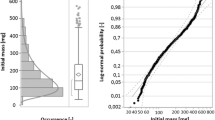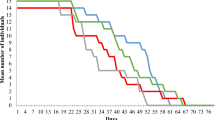Abstract
An electrohydrodynamic (EHD) system with a point-to-plane electrode, which produced air ions within a strong electric field, was used to study mortalities of pupae, larvae, and adults of Tribolium confusum (TC) and larvae of Plodia interpunctella (PI). The treatments included a neutral air stream, negative ions, positive ions, and the air stream superimposed with ions of either polarity. The negative ions caused the maximum mortality in TC pupae and PI larvae whereas the TC adults were least affected, but the negative ion flux was higher than the positive one at the constant high voltage of the power supply used in the present experiments. The differences in the mean mortalities of the treatment groups were highly significant (P<0.0001). Mortality was primarily attributed to the body fluid losses caused by the electric wind of the EHD system. Mortality and weight loss relationships were linear with negative slopes (r 2=0.52, and r 2=0.98 for TC and PI, respectively). The superimposition of the air stream with either positive or negative ion fluxes increased the survival fractions compared with those of the ion fluxes alone.
Similar content being viewed by others
Author information
Authors and Affiliations
Additional information
Received: 27 May 1996 / Accepted: 9 September 1996
Rights and permissions
About this article
Cite this article
Shayesteh, N., Barthakur, N. Electrohydrodynamic mortality of insects: a plausible mechanism. Int J Biometeorol 40, 86–90 (1997). https://doi.org/10.1007/s004840050023
Issue Date:
DOI: https://doi.org/10.1007/s004840050023




